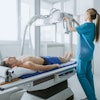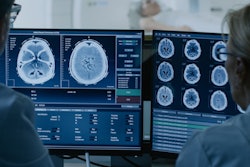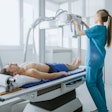
Despite a variety of efforts over the years to facilitate electronic image exchange, adoption has been slow, and many institutions still continue to rely on CDs or DVDs for sharing medical images.
However, this continued reliance on outdated physical storage media is time-consuming, costly, environmentally unsound, and impacts patient care, according to Christoph Wald, MD, PhD, chair of radiology at Lahey Hospital and Medical Center in Boston and a professor at Tufts University Medica School.
Today, "Wireless access and secure cloud technology are becoming ubiquitous in patient's personal lives and [these technologies] are also used by hospitals," said Wald, who also serves as chair of the American College of Radiology (ACR) Commission on Informatics. "Increasingly, patient's personal devices -- laptops, tablets, and smartphones -- lack disc readers. This leads to a very inefficient way to manage image exchange."
Consequently, facilities must devote resources to burning and managing discs, but patients are also sometimes forced to travel hours to retrieve their studies.
"In many cases, radiologists and patients are stuck with a very inefficient system," observed David Larson, MD, senior vice chair for strategy and clinical operations in the department of radiology at Stanford Medicine.
Although the problem isn't new, there's now a growing effort to eliminate the disc. In some cases, medical facilities are working with others to create networks that support electronic image exchange. For example, the Mayo Clinic in Rochester, MN, has emerged as a leader in the space. Meanwhile, the RSNA continues to advance initiatives that aim to establish standards and formats.
Image matters
No one knows exactly how many discs medical facilities burn and distribute each year, but, anecdotally, Larson believes that approximately two-thirds to three-quarters of radiological images shared across unaffiliated institutions wind up on a disc. At some institutions, costs can run into the hundreds of thousands of dollars -- or more.
The problem extends beyond costs, however. The medical field is reliant on patients to manually transport discs, yet many new PCs aren't equipped with CD or DVD drives, noted Howard Forman, MD, a professor of radiology at Yale University. As a result, repeat images -- and additional radiation doses for patients -- isn't uncommon.
"Institutions and individuals should be able to readily access, share, download, or upload images to and from a medical record," Forman said.
Forman and others say that proprietary standards, which typically benefit individual companies but take a toll on the healthcare system, are at the root of the problem. Today's cloud-sharing systems fully support electronic imaging.
"An institution shouldn't have to rely on a proprietary cloud sharing system," he argued.
So far, efforts to move to the cloud have been largely voluntary.
"We are starting to see some local networks in limited geographic areas that have shifted to electronic delivery, but it is not the norm," Larson said.
For example, Mayo Clinic has worked with a group of preferred vendors to establish greater interoperability. It focused on using existing infrastructure and reducing the need for users to revamp their systems. In 2019, it crossed the threshold of more than 50% of images going the route of electronic transfer, says Amy Kotsenas, MD, a consultant in the department of radiology at the Mayo Clinic.
The Mayo Clinic supplemented this effort by interacting with vendors on behalf of individual physicians and offices.
"As a very large customer, the vendors will often address things more quickly when we bring it to their attention rather than having much smaller referring sites take on that responsibility," Kotsenas explained.
In the Metro Boston area, Wald and others have also focused on building a local network of institutions that can share images. Patient medical record matching provided by a leading electronic EMR vendor in that market extends across facilities. Electronic image exchange has helped streamline processes and speed deliveries -- even with different preferred image-exchange vendors.
"We have made some significant progress," Wald said.
Forward thinking
Tackling the image problem requires a focus on metadata as well as pictures, Wald noted.
"If I want to make a comparison of a current study with a prior study that comes from somewhere else, the last thing I want our radiologists to have to do is look at that prior study in a different viewer and a different software," Wald said.
This manual approach can complicate workflows, prevent viewing and analysis with customary tools, and consume time and other resources.
In fact, ensuring that both images and nonimage data flow between systems is critical, according to Larson.
"Once you address the master patient index challenge things get a lot easier," Larson said. "The provider can see the date of service and what imaging has been performed on the patient. They can then request those images from the institution, which can be shared through a direct institution-to-institution transfer."
Yet, establishing an integrated, nationwide system for electronic image exchange has so far remained elusive.
The RSNA launched its Image Share Network initiative in 2009. In 2018, the American College of Radiology (ACR) launched a Ditch the Disk task force, later joined by the RSNA and industry partners.
More recently, the RSNA began working with the non-profit Sequoia Project to establish a set of compliance standards. Its Image Share Validation Program offers confirmation that vendors of image-sharing products meet quality standards published by IHE International. Carequality offers an interoperability framework that supports electronic image exchange, including through web browsers. So far, several vendors have been certified as compliant.
Among those optimistic that the industry is turning a corner is David Mendelson, MD, a professor of radiology at the Icahn School of Medicine at Mt. Sinai in New York City and a leading proponent of simplified image exchange.
"After many years of effort ... we are on the verge of an era where easy, safe, secure will be possible," he noted in a recent presentation.
Making discs disappear
Widespread adoption of electronic imaging would likely have a substantial effect on radiology practice.
At Mayo Clinic, "It has greatly improved image availability," Kotsenas said "Mayo Clinic providers can make more informed decisions about transferring patients or confirming the local physicians have an appropriate treatment plan so patients and their families don't have to travel unnecessarily."
What's more, "Our teams are better prepared to care for them the moment they arrive," Kotsenas added. "In radiology, we are also much more likely to have relevant comparison studies when we perform follow-up exams."
Finally, it has helped reduce manual tasks and the costs associated with CDs throughout its network. In the past, 30 full-time equivalents (FTEs) were required to process physical discs, and another 32 FTEs were needed to match images to the correct patient.
For now, a good way for institutions to address the challenge is to build a hub around which clinics, physicians and others can exchange images, Kotsenas explains. She suggests starting with the largest referral partners, getting quick wins, and continuing to incorporate smaller referrers.
"Patience and persistence is key," she said.
At the same time, Larson suggests that radiologists and others make their presence felt by pressuring hospital systems to take steps that facilitate electronic image exchange.
In addition, "If a facility is considering contracting with an image-exchange vendor, it's critical that the vendor supports image exchange with parties outside their internal network," Larson said. "We, as a profession, must hold ourselves and our industry partners accountable to making electronic image exchange seamless."
To be sure, cloud computing, software, and even EMRs now support a more advanced electronic image exchange environment.
"The time has come to wring out the inefficiencies of CDs and establish a framework that reflects the needs of today's medical environment," Wald concluded.



















